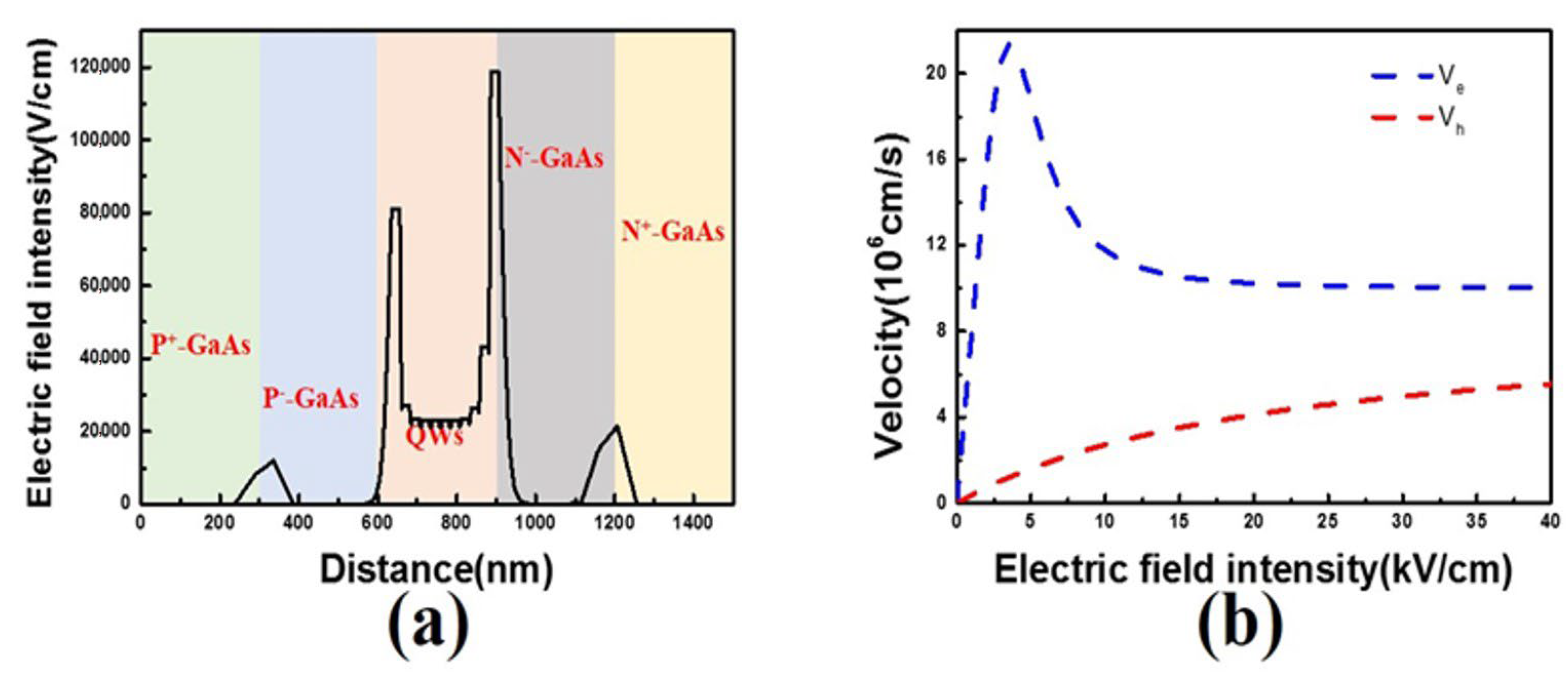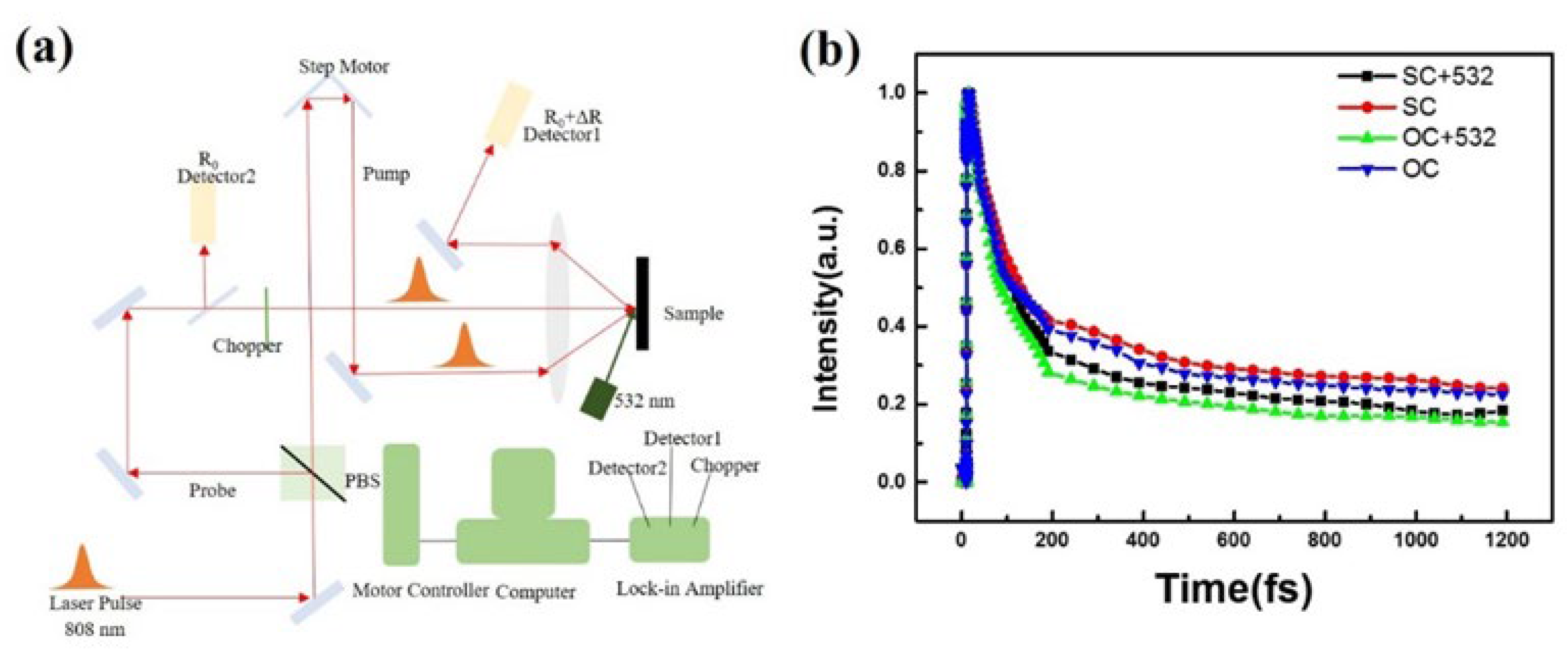Analysis of Photo-Generated Carrier Escape in Multiple Quantum Wells
Abstract
:1. Introduction
2. Analysis and Discussion
3. Conclusions
Author Contributions
Funding
Data Availability Statement
Conflicts of Interest
References
- Bushnell, D.B.; Tibbits, T.N.D.; Barnham, K.W.J.; Connolly, J.P.; Mazzer, M.; Ekins-Daukes, N.J.; Roberts, J.S.; Hill, G.; Airey, R. Effect of well number on the performance of quantum-well solar cells. J. Appl. Phys. 2005, 97, 124908. [Google Scholar] [CrossRef]
- Courel, M.; Rimada, J.C.; Hernández, L. GaAs/GaInNAs quantum well and superlattice solar cell. Appl. Phys. Lett. 2012, 100, 073508. [Google Scholar] [CrossRef]
- Wang, S.; Long, H.; Zhang, Y.; Chen, Q.; Dai, J.; Zhang, S.; Chen, J.; Liang, R.; Xu, L.; Wu, F.; et al. Monolithic integration of deep ultraviolet LED with a multiplicative photoelectric converter. Nano Energy 2019, 66, 104181. [Google Scholar] [CrossRef]
- Elahi, E.; Suleman, M.; Nisar, S.; Sharma, P.R.; Iqbal, M.W.; Patil, S.A.; Kim, H.; Abbas, S.; Chavan, V.D.; Dastgeer, G.; et al. Robust approach towards wearable power efficient transistors with low subthreshold swing. Mater. Today Phys. 2022, 30, 100943. [Google Scholar] [CrossRef]
- Dastgeer, G.; Nisar, S.; Shahzad, Z.M.; Rasheed, A.; Kim, D.K.; Jaffery, S.H.A.; Eom, J. Low-Power Negative-Differential-Resistance Device for Sensing the Selective Protein via Supporter Molecule Engineering. Adv. Sci. 2023, 10, 2204779. [Google Scholar] [CrossRef] [PubMed]
- Dastgeer, G.; Shahzad, Z.M.; Chae, H.; Kim, Y.H.; Ko, B.M.; Eom, J. Bipolar Junction Transistor Exhibiting Excellent Output Characteristics with a Prompt Response against the Selective Protein. Adv. Funct. Mater. 2022, 32, 2204781. [Google Scholar] [CrossRef]
- Dastgeer, G.; Afzal, A.M.; Aziz, J.; Hussain, S.; Jaffery SH, A.; Kim, D.K.; Assiri, M.A. Flexible memory device composed of metal-oxide and two-dimensional material (SnO2/WTe2) exhibiting stable resistive switching. Materials 2021, 14, 7535. [Google Scholar] [CrossRef] [PubMed]
- Dastgeer, G.; Afzal, A.M.; Jaffery, S.H.A.; Imran, M.; Assiri, M.A.; Nisar, S. Gate modulation of the spin current in graphene/WSe2 van der Waals heterostructure at room temperature. J. Alloys Compd. 2022, 919, 165815. [Google Scholar] [CrossRef]
- Dastgeer, G.; Afzal, A.M.; Nazir, G.; Sarwar, N. p-GeSe/n-ReS2 heterojunction rectifier exhibiting a fast photoresponse with ultra-high frequency-switching applications. Adv. Mater. Interfaces 2021, 8, 2100705. [Google Scholar] [CrossRef]
- Yeh, D.-M.; Huang, C.-F.; Chen, C.-Y.; Lu, Y.-C.; Yang, C.C. Surface plasmon coupling effect in an InGaN∕GaN single-quantum-well light-emitting diode. Appl. Phys. Lett. 2007, 91, 171103. [Google Scholar] [CrossRef]
- Yadav, G.; Dewan, S.; Tomar, M. Electroluminescence study of InGaN/GaN QW based p-i-n and inverted p-i-n junction based short-wavelength LED device using laser MBE technique. Opt. Mater. 2022, 126, 112149. [Google Scholar] [CrossRef]
- Ahmad, S.; Raushan, M.; Kumar, S.; Dalela, S.; Siddiqui, M.; Alvi, P. Modeling and simulation of GaN based QW LED for UV emission. Optik 2018, 158, 1334–1341. [Google Scholar] [CrossRef]
- Hansen, M.; Piprek, J.; Pattison, P.M.; Speck, J.S.; Nakamura, S.; DenBaars, S.P. Higher efficiency InGaN laser diodes with an improved quantum well capping configuration. Appl. Phys. Lett. 2002, 81, 4275–4277. [Google Scholar] [CrossRef]
- Tansu, N.; Mawst, L.J. Current injection efficiency of InGaAsN quantum-well lasers. J. Appl. Phys. 2005, 97, 054502. [Google Scholar] [CrossRef]
- Margetis, J.; Zhou, Y.; Dou, W.; Grant, P.C.; Alharthi, B.; Du, W.; Wadsworth, A.; Guo, Q.; Tran, H.; Ojo, S.; et al. All group-IV Si-GeSn/GeSn/SiGeSn QW laser on Si operating up to 90 K. Appl. Phys. Lett. 2018, 113, 221104. [Google Scholar] [CrossRef]
- Pan, J.L.; Fonstad, C.G. Theory, fabrication and characterization of quantum well infrared photodetectors. Mater. Sci. Eng. R Rep. 2000, 28, 65–147. [Google Scholar] [CrossRef]
- Zhou, X.; Li, N.; Lu, W. Progress in quantum well and quantum cascade infrared photodetectors in SITP. Chin. Phys. B 2019, 28. [Google Scholar] [CrossRef]
- Wu, W.; Bonakdar, A.; Mohseni, H. Plasmonic enhanced quantum well infrared photodetector with high detectivity. Appl. Phys. Lett. 2010, 96, 161107. [Google Scholar] [CrossRef]
- Seeger, K. Semiconductor Physics; Springer Science & Business Media: Berlin/Heidelberg, Germany, 2013. [Google Scholar]
- Sun, Q.; Wang, L.; Wang, Y.; Ma, Z.; Chen, H. Direct Observation of Carrier Transportation Process in InGaAs/GaAs Mul-tiple Quantum Wells Used for Solar Cells and Photodetectors. Chin. Phys. Lett. 2016, 33, 103–106. [Google Scholar] [CrossRef]
- Wu, H.; Ma, Z.; Jiang, Y.; Wang, L.; Yang, H.; Li, Y.; Zuo, P.; Jia, H.; Wang, W.; Zhou, J.; et al. Direct observation of the carrier transport process in InGaN quantum wells with a pn-junction. Chin. Phys. B 2016, 25, 117803. [Google Scholar] [CrossRef]
- Li, Y.; Jiang, Y.; Die, J.; Wang, C.; Yan, S.; Wu, H.; Ma, Z.; Wang, L.; Jia, H.; Wang, W.; et al. Visualizing light-to-electricity conversion process in InGaN/GaN multi-quantum wells with a p–n junction. Chin. Phys. B 2018, 27, 097104. [Google Scholar] [CrossRef]
- Yang, H.; Ma, Z.; Jiang, Y.; Wu, H.; Zuo, P.; Zhao, B.; Jia, H.; Chen, H. The enhanced photo absorption and carrier transport tation of InGaN/GaN Quantum Wells for photodiode detector applications. Sci. Rep.-UK 2017, 7, 43357. [Google Scholar] [CrossRef]
- Lim, S.; Ko, Y.; Cho, Y. A quantitative method for determination of carrier escape efficiency in GaN-based light-emitting diodes: A comparison of open- and short-circuit photoluminescence. Appl. Phys. Lett. 2014, 104, 91104. [Google Scholar] [CrossRef]
- Watanabe, N.; Mitsuhara, M.; Yokoyama, H.; Liang, J.; Shigekawa, N. Influence of InGaN/GaN multiple quantum well structure on photovoltaic characteristics of solar cell. Jpn. J. Appl. Phys. 2014, 53, 112301. [Google Scholar] [CrossRef]
- Lang, J.R.; Young, N.G.; Farrell, R.M.; Wu, Y.-R.; Speck, J.S. Carrier escape mechanism dependence on barrier thickness and temperature in InGaN quantum well solar cells. Appl. Phys. Lett. 2012, 101, 181105. [Google Scholar] [CrossRef]
- Schubert, M.F.; Xu, J.; Dai, Q.; Mont, F.W.; Kim, J.K.; Schubert, E.F. On resonant optical excitation and carrier escape in GaInN/GaN quantum wells. Appl. Phys. Lett. 2009, 94, 081114. [Google Scholar] [CrossRef]
- Song, J.-H.; Kim, H.-J.; Ahn, B.-J.; Dong, Y.; Hong, S.; Song, J.-H.; Moon, Y.; Yuh, H.-K.; Choi, S.-C.; Shee, S. Role of photovoltaic effects on characterizing emission properties of InGaN/GaN light emitting diodes. Appl. Phys. Lett. 2009, 95, 263503. [Google Scholar] [CrossRef]
- Wang, W.; Wang, L.; Jiang, Y.; Ma, Z.; Sun, L.; Liu, J.; Sun, Q.; Zhao, B.; Wang, W.; Liu, W.; et al. Carrier transport in III–V quantum-dot structures for solar cells or photodetectors. Chin. Phys. B 2016, 25, 097307. [Google Scholar] [CrossRef]
- Zou, Y.; Honsberg, C.B.; Freundlich, A.; Goodnick, S.M. Simulation of Electron Escape fromGaNAs/GaAsQuantum Well Solar Cells. In Proceedings of the 2014 IEEE 40th Photovoltaic Specialist Conference (PVSC), Denver, CO, USA, 8–13 June 2014. [Google Scholar]
- Tang, X.; Li, X.; Yue, C.; Wang, L.; Deng, Z.; Jia, H.; Wang, W.; Ji, A.; Jiang, Y.; Chen, H. Research on photo-generated carriers escape in PIN and NIN structures with quantum wells. Appl. Phys. Express 2020, 13, 071009. [Google Scholar] [CrossRef]
- Busch, P.; Heinonen, T.; Lahti, P. Heisenberg’s uncertainty principle. Phys. Rep. 2007, 452, 155–176. [Google Scholar] [CrossRef]




Disclaimer/Publisher’s Note: The statements, opinions and data contained in all publications are solely those of the individual author(s) and contributor(s) and not of MDPI and/or the editor(s). MDPI and/or the editor(s) disclaim responsibility for any injury to people or property resulting from any ideas, methods, instructions or products referred to in the content. |
© 2023 by the authors. Licensee MDPI, Basel, Switzerland. This article is an open access article distributed under the terms and conditions of the Creative Commons Attribution (CC BY) license (https://creativecommons.org/licenses/by/4.0/).
Share and Cite
Guo, J.; Liu, W.; Ding, D.; Tan, X.; Zhang, W.; Han, L.; Wang, Z.; Gong, W.; Li, J.; Zhai, R.; et al. Analysis of Photo-Generated Carrier Escape in Multiple Quantum Wells. Crystals 2023, 13, 834. https://doi.org/10.3390/cryst13050834
Guo J, Liu W, Ding D, Tan X, Zhang W, Han L, Wang Z, Gong W, Li J, Zhai R, et al. Analysis of Photo-Generated Carrier Escape in Multiple Quantum Wells. Crystals. 2023; 13(5):834. https://doi.org/10.3390/cryst13050834
Chicago/Turabian StyleGuo, Jiaping, Weiye Liu, Ding Ding, Xinhui Tan, Wei Zhang, Lili Han, Zhaowei Wang, Weihua Gong, Jiyun Li, Ruizhan Zhai, and et al. 2023. "Analysis of Photo-Generated Carrier Escape in Multiple Quantum Wells" Crystals 13, no. 5: 834. https://doi.org/10.3390/cryst13050834
APA StyleGuo, J., Liu, W., Ding, D., Tan, X., Zhang, W., Han, L., Wang, Z., Gong, W., Li, J., Zhai, R., Jia, Z., Ma, Z., Du, C., Jia, H., & Tang, X. (2023). Analysis of Photo-Generated Carrier Escape in Multiple Quantum Wells. Crystals, 13(5), 834. https://doi.org/10.3390/cryst13050834





